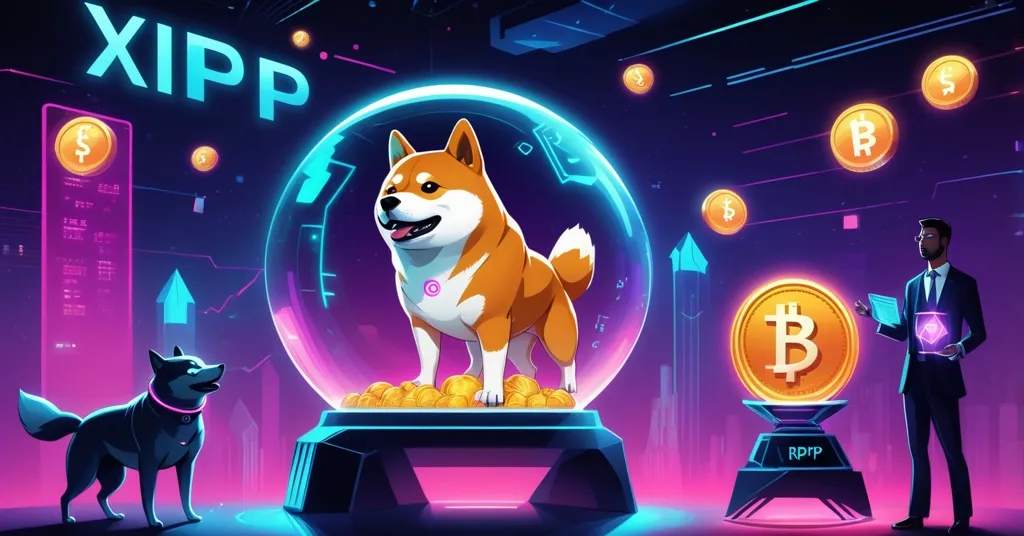ChatGPT’s 2025 Crypto Predictions: XRP to $10, Pepe & Shiba Inu to Triple—Hype or Hoax?

ChatGPT’s 2025 Crypto Forecasts: XRP to $10, Pepe and Shiba Inu to Triple—Hype or Reality?
ChatGPT has thrown its hat into the crypto prediction ring, forecasting jaw-dropping gains for XRP, Pepe, and Shiba Inu by the end of 2025. With XRP potentially hitting $10 and meme coins poised for 2-3x surges, the AI’s bold claims are making waves—but are they grounded in reality or just algorithmic wishful thinking? Let’s slice through the buzz with a critical eye and unpack what’s driving these projections.
- XRP’s Bullish Run: Predicted to reach $10 by 2025 after a 400% yearly surge, fueled by legal wins and institutional adoption.
- Meme Coin Madness: Pepe and Shiba Inu could see massive gains, tied to Ethereum’s recent $2,950 peak, though volatility is a constant shadow.
- Snorter Presale Hype: A trading bot raising $3.4M with lofty promises, but transparency is nowhere to be found—proceed with caution.
XRP: Legal Triumphs and Looming Questions
XRP, the token powering Ripple’s cross-border payment network, has been on a tear, racking up a staggering 400% gain over the past year and smashing through the $1 barrier. ChatGPT’s prediction of a $10 price by 2025—a 2x rally from current heights—depends on XRP breaking key resistance at $3.66, a technical price point where selling pressure often overwhelms buying, potentially stalling momentum. What’s behind this surge? A landmark victory against the U.S. Securities and Exchange Commission (SEC) in a grueling lawsuit has washed away much of the regulatory stink that clung to XRP for years, boosting investor confidence. For those new to this saga, the SEC had accused Ripple Labs of selling XRP as an unregistered security since 2020, a claim that was largely dismissed in court, marking a win for altcoins facing similar scrutiny.
More fuel for the fire comes from real-world adoption. Gemini, a major crypto exchange, recently launched an XRP credit card, allowing users to spend the token directly—a practical step toward mainstream use. Rumors of an XRP ETF launching in October 2025 are swirling, which could unleash a flood of institutional money. Ripple’s CEO, Brad Garlinghouse, has even projected XRP capturing 14% of SWIFT’s $21 trillion annual transaction volume within five years, a bold claim backed by strategic moves like the $200 million acquisition of Rail, a stablecoin payment firm. Yet, before we get carried away, XRP’s centralized structure—Ripple holds significant control over token supply and validator nodes—clashes with the decentralized ethos that defines crypto’s rebellious spirit. Bitcoin, by contrast, answers to no corporate overlord. Plus, stablecoins like USDT and USDC are nipping at XRP’s heels as bridge currencies for payments. If adoption falters or regulators circle back with appeals, that $10 dream could turn into a harsh wake-up call.
Meme Coins: Riding Ethereum’s Coattails or Crashing Hard?
Now, let’s wade into the chaotic swamp of meme coins—tokens like Pepe and Shiba Inu that are less about utility and more about internet memes, community hype, and wild speculation. For the uninitiated, these are cryptocurrencies often inspired by cultural gags (think cartoon frogs or cute dogs) that thrive on viral marketing rather than tangible use cases. ChatGPT predicts Pepe, an Ethereum-based token, could climb to $0.00002–$0.00003 by 2025, a 2-3x jump from current levels, while Shiba Inu, down 20% over the past year, is slated for a strong rebound, though specific targets remain vague beyond breaking resistance at $0.00013. Shiba Inu’s RSI (Relative Strength Index, a momentum indicator showing if a token is overbought or oversold) sits at 44, edging toward undervalued territory, which could hint at a buying opportunity—or just another false signal.
Both tokens owe much of their price action to Ethereum’s recent rally to $2,950, a significant milestone that’s juiced trading volume for ERC-20 tokens built on its blockchain. (Note: some discrepancies exist in reported ETH highs, with past peaks near $4,800 and Pepe’s all-time high of $0.000024 tied to an ETH price of $3,900, suggesting data confusion we can’t fully resolve without real-time stats.) When Ethereum pumps, meme coins often follow, as speculators pile into cheaper, riskier assets hoping for quick gains. Shiba Inu’s past burn mechanisms—destroying tokens to reduce supply and theoretically boost value—have fueled hype cycles, while Pepe’s community-driven stunts on social media keep its frog meme buzzing. But let’s not kid ourselves: these are speculative gambles, not investments. Meme coins are notorious for pump-and-dump schemes, rug pulls (where developers vanish with investor funds), and soul-crushing volatility tied to Ethereum trends. So, a 2-3x gain by 2025? Sure, if Twitter memes go viral and ETH moons again. Otherwise, you’re just playing crypto roulette with extra steps.
Snorter Presale: Shiny Promises or Shady Cash Grab?
Enter Snorter, a Telegram-based crypto trading bot that’s raised over $3.4 million in its presale at $0.099 per token. Pitched as a game-changer for fast, secure trades, it touts features like a low 0.85% transaction fee, MEV protection (a safeguard against miners manipulating transaction order for profit), and a staggering 131% APY (Annual Percentage Yield, the return on staked assets) for staking. Sounds like a dream for degens chasing yield, right? Not so fast. There’s zero mention of audits, team credentials, or regulatory oversight—glaring omissions in a space where over 80% of presale projects either flop or turn out to be outright scams. Think Squid Game token, a 2021 disaster that rug-pulled investors for millions after hyping a fake play-to-earn game. Snorter’s aggressive marketing reeks of a FOMO-driven cash grab targeting retail investors desperate for the next 100x. High returns almost always mean high risks, if not a straight path to getting burned. Until there’s a whitepaper, GitHub activity, or third-party validation for Snorter, this is just another shiny object in a market littered with broken promises. If you’re tempted, remember: caveat emptor—buyer beware.
AI Predictions: Data-Driven or Just Digital Daydreams?
Let’s address the elephant in the room: relying on ChatGPT for crypto price predictions is like asking a Magic 8-Ball for stock tips—fun, but hardly actionable. AI models like these scrape historical data and social media sentiment to spit out forecasts, but they’re clueless about black-swan events (unexpected market shocks), regulatory bombshells, or macroeconomic shifts like interest rate hikes that can gut risk assets. XRP at $10 could happen if an ETF sparks a buying frenzy and Ripple displaces chunks of SWIFT’s dominance. Pepe and Shiba Inu tripling might materialize if Ethereum soars and meme mania grips retail again. But these projections are speculative fiction, not financial gospel. On the flip side, AI can highlight undervalued trends or historical patterns worth a second look, sparking curiosity if not conviction. Still, in a space as unpredictable as crypto, human skepticism trumps algorithmic forecasts every time.
Bitcoin’s Bedrock: Why It Still Towers Over Altcoin Frenzy
Amidst this altcoin circus, let’s not lose sight of the real revolutionary force: Bitcoin. While XRP fills a niche for cross-border payments (albeit with centralized baggage), and meme coins cater to speculative thrill-seekers, Bitcoin remains the unassailable standard of decentralization, privacy, and freedom from gatekeepers. Ripple’s control over XRP’s supply and validators undercuts the ethos of unshackling finance from corporate or governmental oversight—a mission Bitcoin embodies with every trustless transaction. Meme coins, with their hype-over-substance model, often distract from crypto’s potential to disrupt oppressive systems, while presales like Snorter raise legitimacy concerns and exploit retail naivety in ways Bitcoin’s transparent, battle-tested network never could. Altcoins and innovative protocols like Ethereum have roles to play—filling gaps Bitcoin doesn’t (and perhaps shouldn’t) address, from smart contracts to niche utilities—but they’re often detours from the core fight for financial sovereignty. As we chase effective accelerationism, pushing tech to dismantle the status quo, Bitcoin’s blueprint of a freer future is the hill worth defending.
Key Questions and Takeaways for Crypto Enthusiasts
- What’s powering XRP’s potential surge to $10 by 2025?
A 400% yearly gain, an SEC lawsuit victory, Gemini’s XRP credit card launch, and a possible ETF launch in October 2025 are major catalysts, though centralized control via Ripple and stablecoin competition pose risks. - Can Pepe and Shiba Inu really deliver 2-3x gains in two years?
ChatGPT ties their potential to Ethereum’s performance, recently hitting $2,950, but their lack of utility and extreme volatility make these forecasts a high-stakes gamble, not a sure bet, as discussed in community predictions. - Is Snorter’s $3.4M presale a hidden gem or a trap?
With promises of 131% APY and MEV protection, it’s enticing, but no audits or transparency scream red flags—approach with extreme caution, if at all. - How much trust should we place in ChatGPT’s crypto predictions?
Very little; while AI can spot patterns, it misses unpredictable factors like regulation or macro shifts, rendering forecasts more speculative than reliable. - Why does Bitcoin still outshine altcoins in this hype cycle?
Bitcoin’s unwavering focus on decentralization and privacy stands as the true disruptor, unlike XRP’s centralization or meme coins’ empty speculation, keeping it the cornerstone of financial revolution.
XRP’s trajectory shows glimmers of real-world impact, but its centralized roots and competitive landscape temper the hype. Meme coins like Pepe and Shiba Inu are a wild ride—entertaining to watch, reckless to bet on without ironclad risk tolerance. Snorter’s presale, with its unchecked promises, feels like another potential fleecing of retail dreamers, and ChatGPT’s predictions are a curiosity, not a crystal ball. The crypto space is a battlefield of innovation and deception, where true disruption lies in systems no one can control. As altcoins dazzle with promises, keep your eyes on the prize: a decentralized future, with Bitcoin leading the charge. Stay sharp, question the noise, and never fall for the next shiny scam without doing your damn homework.



